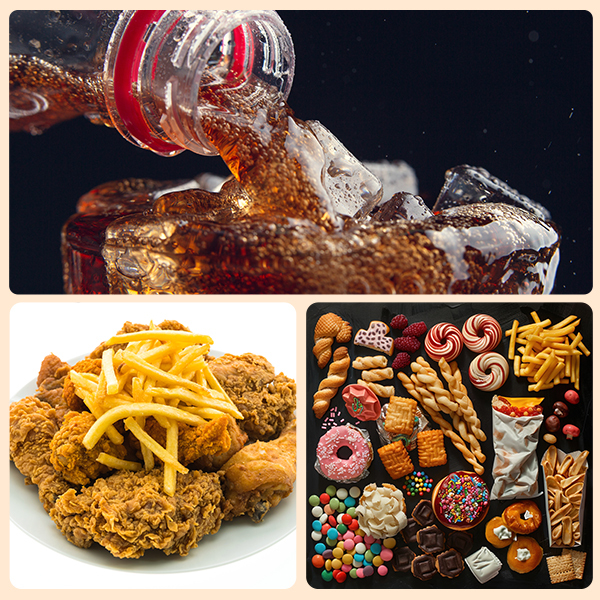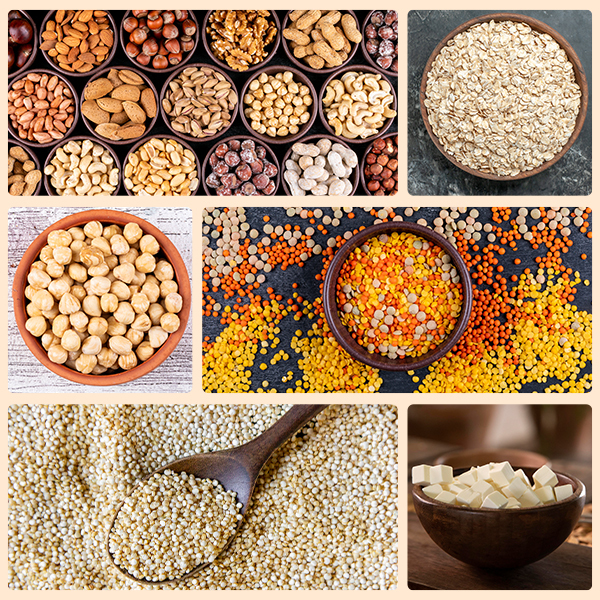Build Lean Muscle: Best Protein-Packed Foods to Fuel Growth
Blogs14 Jul 2025
IN THIS ARTICLE
Protein-rich diets are all the rage right now, and rightly so. Recent findings have found that moderately increasing protein consumption over the required daily intake for older adults (assigned by health organisations) can lead to better control of weight and support muscle mass as well. And since the decrease in muscle mass and functional capacity is a natural factor of ageing, protein can help you delay it for longer, keeping you active and strong in your 40s-60s.
In this article, we’ll take you through the top high-protein foods for muscle maintenance that you should include in your meals if you want to increase your protein intake and prioritise healthy ageing.
Why Is Protein Important For Building Muscle?
Protein plays a central role in muscle development. When you work out, especially during resistance training, your muscle fibres undergo small strains and break down. Consuming proteins for muscle growth helps repair and rebuild these fibres, making them lean and stronger over time.
This process, known as muscle protein synthesis, requires a steady supply of amino acids, which are the building blocks of protein. A diet that doesn’t include enough protein can slow muscle growth, even if your workout routine is on point. That’s why understanding how much protein to build muscle mass is essential for visible, long-term results.
Who Needs Protein More?
While everyone needs protein, some people require higher amounts due to their activity level, age, or health goals. Athletes, bodybuilders, and those recovering from injury are among those who benefit from higher protein consumption. Additionally, older adults often require more protein to prevent age-related muscle loss.
Knowing how much protein per day for muscle building depends on body weight and lifestyle. A general guideline for active adults is 1.0 to 1.6 grams of protein per kilogram of body weight. This ensures your muscles have enough fuel to repair, grow, and stay strong.
Top Muscle-Building Foods You Need to Have To Maintain Muscle Mass
1. Dairy Products
Our pick of high-protein dairy sources is Greek yoghurt, low-fat milk, and paneer. Greek Yoghurt is a dairy protein that can be had as a snack to increase your protein intake for muscle gain. A study found that a group of men who consumed Greek yoghurt regularly for 12 weeks had improved strength, muscle thickness, and body composition than those who didn’t drink it. It’s a source of all essential amino acids, making it an excellent addition to your daily meals.
Moreover, research has found that drinking milk post-exercise can increase muscle protein synthesis. And when milk consumption is combined with regular resistance training, it may also increase muscle hypertrophy and lean mass. Dairy products are among the best foods for building muscle mass, especially when paired with strength training.
Cottage cheese or paneer is another dairy protein that may aid in maintaining muscle mass. Popularly used in several vegetarian dishes, you can prioritise having this protein source if you stay away from meat.
2. Non-dairy (Vegan-friendly Options)
Sattu and Oats
Sattu is a flour made of roasted grains that is enriched with calcium, magnesium, iron, and sodium, along with fibre and protein. You can have it with curd and spices for a protein-rich buttermilk. You can also cook with it to make flatbreads, tikkis, etc., for protein-filled snacks and meals. As a plant-based source of protein, sattu supports protein for muscle growth and fits well intothe list of vegan foods that build muscle.
Oats are a popular cereal due to their excellent nutritional value, which contains soluble dietary fibre, protein, vitamins, and minerals. The many oats benefits include supporting digestion, sustained energy, and muscle repair. Oats are often had as breakfast along with milk. However, vegans can consume them in recipes like oats khichdi, oats dosa, and so on to get the best out of them.
Legumes and lentils
Legumes or pulses are an essential part of our Indian cooking. They contain fibre, carbohydrates, vitamins, iron, copper, magnesium, manganese, zinc, phosphorus, and protein too. The nutritional value of pulses makes them a smart choice; they’re typically low in fat and free of cholesterol, making them perfect for healthy eating.
Even lentils of all types are sources of plant-based protein and are a viable alternative to animal-based protein sources when taken strategically. They are easy to cook and wholesome in taste, so make sure to add them to your meals for a good dose of nutrition!
Nuts & Seeds
You may not know this, but many readily available nuts and seeds in your kitchen may be sources of protein! If you want to snack on a few, here’s what you should pick: peanuts, almonds, and pumpkin seeds.
The protein derived from peanuts offers almost all essential amino acids, only being low for methionine and threonine. Meanwhile, almonds also contain one of the highest amounts of protein among other nuts and make for a great addition for those looking to keep fit and maintain muscle mass. These are among the best dry fruits to include in your daily routine for sustained energy and strength.
And if you’re making a high-protein trail mix with peanuts and almonds, be sure also to add pumpkin seeds. These seeds are bursting with nutrition as they contain Vitamin B benefits, along with Vitamins C, E, and K, and a high amount of protein too. They are great for keeping your muscles and your overall body healthy.
Tofu, Chickpea, and Quinoa
For those who only consume plant-based products and want to include more plant-based protein in their diets, try tofu, chickpeas and quinoa.
Tofu is a soy protein perfect for stir-fries, wraps, noodle bowls and more. It’s entirely vegan and some studies have found that it can promote fat loss, preserve muscle mass and support lean body mass gains. Tofu also offers micronutrients like calcium and Vitamin K, which support bone strength and overall muscle function.
Another vegan protein source, chickpea is a good source of protein and fibre. It can help fill your daily required protein intake and support your overall health too. Some benefits of having chickpeas include supporting heart health, bone health and weight management.
Lastly, when it comes to plant protein, quinoa is another great source as it contains all essential amino acids that can positively impact muscle growth and repair. It also helps prevent or delay conditions that could lead to muscle wasting and age-related muscle loss.
3. Non-vegetarian options
Lean meat and Eggs
If you want to build muscle mass and repair your tissues, then choose chicken, fish and eggs.
Chicken is a classic fixture in a high-protein diet for muscle mass that’s also readily available in India. It’s also easy to prepare and there are a ton of delicious and healthy dishes you can cook with it. Secondly, fish is a highly nutritious type of seafood and ranks high in the list of high-protein foods for muscle mass. They typically contain all essential amino acids and important micronutrients that can help in repairing tissues, regulating systems and maintaining the quality of blood. Additionally, egg protein is highly digestible and a great source of amino acids. It’s important for skeletal muscle health and protects against age-related muscle loss.
What happens when we have too little protein?
Too little protein in your diet can weaken muscle repair and slow growth. Without enough proteins for muscle growth, recovery takes longer, and strength gains may stall. Over time, the body may even lose muscle.
Skipping key foods that build muscles makes it harder to meet your daily needs. Even active individuals may fall short if they rely heavily on processed or low-nutrient foods. Prioritising whole, nutrient-rich options like oats, pulses, and dry fruits ensures your protein intake supports growth, strength, and overall health.
What foods To Limit Or Avoid Building Muscle?
The food we eat is essential not only to fuel our energy for our day but also to keep our bodily processes active and going. The above-mentioned best protein foods for muscle gains help in promoting overall health and the maintenance of muscle mass. However, there are a few types of foods that may not support your goals, especially when you're focusing on foods for building muscle mass.

- Fried food
- Carbonated drinks
- Products with excess added sugars
Conclusion
If you’re focused on healthy ageing, it’s time to relook at your protein intake.
Adding protein-rich foods like chicken, fish, tofu, chickpeas, quinoa, and low-fat dairy can help you maintain muscle mass, support muscle repair, and delay age-related muscle loss. This helps you stay active and strong for longer.
For more tips on taking charge of your midlife health, explore Right Shift. Use our Health Score Calculator to assess your current fitness level and our free Meal Plan Creator to build a personalised plan that supports muscle health.
Looking for nourishing everyday options? Try our Millet Oats, Millet Masala Oats, Jaggery Cookies, Jaggery Ragi Cookies, and Jaggery Oats Cookies. These are great additions to a balanced, protein-conscious diet. Prioritise your health and make the Right Shift today.
Other Popular Blogs
How Much Protein Consumption Per Day | Proteins And Diabetes Management | Exercise For Muscle Gain | Foods For Muscle Gain |
FAQs
To gain muscle, you need to incorporate both resistance training and a balanced diet into your routine. Resistance training like weightlifting promotes muscle growth. Your diet should be rich in protein, complex carbohydrates, and healthy fats. It's also important to get enough rest to allow your muscles to recover and grow.
The recommended dietary allowance (RDA) for protein, as prescribed by the Indian Council of Medical Research (ICMR), is 0.8-1.0 grams per kilogram of body weight for an average adult. However, for muscle gain, it's often suggested to consume a bit more, approximately 1.2-2.0 grams of protein per kilogram of body weight. This should be combined with regular strength training for optimal muscle growth. Always consult with a healthcare provider or a nutritionist for personalised advice.
Complete proteins like eggs, chicken, dairy, and soy are best for muscle growth as they contain all essential amino acids. Plant-based options like lentils and pulses also support protein for muscle growth when combined with whole grains.
Your daily protein needs depend on how active you are. For muscle building, intake can range from 1.0 to 1.6 grams of protein per kilogram of body weight. Staying within this range supports proteins for muscle growth and helps improve strength and recovery.
1. https://www.ncbi.nlm.nih.gov/pmc/articles/PMC9316657/
2. https://www.ncbi.nlm.nih.gov/pmc/articles/PMC9182978/
3. https://www.ncbi.nlm.nih.gov/pmc/articles/PMC4608274/
4. https://pubmed.ncbi.nlm.nih.gov/34801804/
5. https://www.ncbi.nlm.nih.gov/pmc/articles/PMC6769807/
6. https://www.ncbi.nlm.nih.gov/pmc/articles/PMC2569005/
7. https://pubmed.ncbi.nlm.nih.gov/26400436/
8. https://www.medicalnewstoday.com/articles/280244#benefits
9. https://www.ncbi.nlm.nih.gov/pmc/articles/PMC6503736/
10. https://www.ncbi.nlm.nih.gov/pmc/articles/PMC8621247/
11. https://www.ncbi.nlm.nih.gov/pmc/articles/PMC9689683/
12. https://pubmed.ncbi.nlm.nih.gov/26797090/






